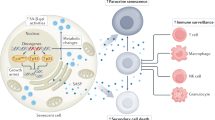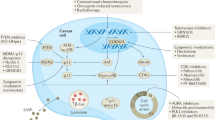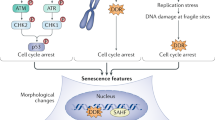Abstract
Cellular senescence is defined as the physiological program of terminal growth arrest, which can be triggered by various endogenous or exogenous stress signals. Cellular senescence can be induced in response to oncogenic activation and acts as a barrier to tumorigenesis. Moreover, tumor cells can undergo senescence when exposed to chemotherapeutic agents. In addition to suppressing tumorigenesis, senescent cells remain metabolically active and may contribute to tumor formation and to therapy resistance. In the current review, we discuss the molecular regulation of cellular senescence, the potential implications of senescence in human cancers, and the possibility of exploiting cellular senescence for the treatment of cancers.
Similar content being viewed by others
Log in or create a free account to read this content
Gain free access to this article, as well as selected content from this journal and more on nature.com
or
References
Campisi J, d'Adda di Fagagna F . Cellular senescence: when bad things happen to good cells. Nat Rev Mol Cell Biol 2007; 8: 729–40.
Hayflick L, Moorhead PS . The serial cultivation of human diploid cell strains. Exp Cell Res 1961; 25: 585–621.
Dimri GP, Lee X, Basile G, Acosta M, Scott G, Roskelley C, et al. A biomarker that identifies senescent human cells in culture and in aging skin in vivo. Proc Natl Acad Sci U S A 1995; 92: 9363–7.
Serrano M, Lin AW, McCurrach ME, Beach D, Lowe SW . Oncogenic ras provokes premature cell senescence associated with accumulation of p53 and p16INK4a. Cell 1997; 88: 593–602.
Narita M, Krizhanovsky V, Nunez S, Chicas A, Hearn SA, Myers MP, et al. A novel role for high-mobility group a proteins in cellular senescence and heterochromatin formation. Cell 2006; 126: 503–14.
Michaloglou C, Vredeveld LC, Soengas MS, Denoyelle C, Kuilman T, van der Horst CM, et al. BRAFE600-associated senescence-like cell cycle arrest of human naevi. Nature 2005; 436: 720–4.
Chandeck C, Mooi WJ . Oncogene-induced cellular senescence. Adv Anat Pathol 2010; 17: 42–8.
Braig M, Schmitt CA . Oncogene-induced senescence: putting the brakes on tumor development. Cancer Res 2006; 66: 2881–4.
Courtois-Cox S, Jones SL, Cichowski K . Many roads lead to oncogene-induced senescence. Oncogene 2008; 27: 2801–9.
Banito A, Rashid ST, Acosta JC, Li S, Pereira CF, Geti I, et al. Senescence impairs successful reprogramming to pluripotent stem cells. Genes Dev 2009; 23: 2134–9.
Kawamura T, Suzuki J, Wang YV, Menendez S, Morera LB, Raya A, et al. Linking the p53 tumour suppressor pathway to somatic cell reprogramming. Nature 2009; 460: 1140–4.
Utikal J, Polo JM, Stadtfeld M, Maherali N, Kulalert W, Walsh RM, et al. Immortalization eliminates a roadblock during cellular reprogramming into iPS cells. Nature 2009; 460: 1145–8.
Wang X, Wong SC, Pan J, Tsao SW, Fung KH, Kwong DL, et al. Evidence of cisplatin-induced senescent-like growth arrest in nasopharyngeal carcinoma cells. Cancer Res 1998; 58: 5019–22.
Di Leonardo A, Linke SP, Clarkin K, Wahl GM . DNA damage triggers a prolonged p53-dependent G1 arrest and long-term induction of Cip1 in normal human fibroblasts. Genes Dev 1994; 8: 2540–51.
Cesinaro AM, Migaldi M, Ferrari G, Castagnetti G, Dotti A, De Gaetani C, et al. Expression of p53 and Bcl-2 in clinically localized prostate cancer before and after neo-adjuvant hormonal therapy. Oncol Res 2000; 12: 43–9.
Bryan TM, Englezou A, Gupta J, Bacchetti S, Reddel RR . Telomere elongation in immortal human cells without detectable telomerase activity. EMBO J 1995; 14: 4240–8.
Hayflick L . The limited in vitro lifetime of human diploid cell strains. Exp Cell Res 1965; 37: 614–36.
Vaziri H, Benchimol S . Reconstitution of telomerase activity in normal human cells leads to elongation of telomeres and extended replicative life span. Curr Biol 1998; 8: 279–82.
Shay JW, Bacchetti S . A survey of telomerase activity in human cancer. Eur J Cancer 1997; 33: 787–91.
Muntoni A, Reddel RR . The first molecular details of ALT in human tumor cells. Hum Mol Genet 2005; 14: R191–6.
Harley CB . Telomerase and cancer therapeutics. Nat Rev Cancer 2008; 8: 167–79.
Pascolo E, Wenz C, Lingner J, Hauel N, Priepke H, Kauffmann I, et al. Mechanism of human telomerase inhibition by BIBR1532, a synthetic, non-nucleosidic drug candidate. J Biol Chem 2002; 277: 15566–72.
Colangelo D, Ghiglia A, Ghezzi A, Ravera M, Rosenberg E, Spada F, et al. Water-soluble benzoheterocycle triosmium clusters as potential inhibitors of telomerase enzyme. J Inorg Biochem 2005; 99: 505–12.
Strahl C, Blackburn EH . The effects of nucleoside analogs on telomerase and telomeres in Tetrahymena. Nucleic Acids Res 1994; 22: 893–900.
Kim MO, Moon DO, Kang SH, Heo MS, Choi YH, Jung JH, et al. Pectenotoxin-2 represses telomerase activity in human leukemia cells through suppression of hTERT gene expression and Akt-dependent hTERT phosphorylation. FEBS Lett 2008; 582: 3263–9.
Ugel S, Scarselli E, Iezzi M, Mennuni C, Pannellini T, Calvaruso F, et al. Autoimmune B-cell lymphopenia after successful adoptive therapy with telomerase-specific T lymphocytes. Blood 2010; 115: 1374–84.
Wei S, Sedivy JM . Expression of catalytically active telomerase does not prevent premature senescence caused by overexpression of oncogenic Ha-Ras in normal human fibroblasts. Cancer Res 1999; 59: 1539–43.
Di Micco R, Fumagalli M, Cicalese A, Piccinin S, Gasparini P, Luise C, et al. Oncogene-induced senescence is a DNA damage response triggered by DNA hyper-replication. Nature 2006; 444: 638–42.
Wynford-Thomas D . p53: guardian of cellular senescence. J Pathol 1996; 180: 118–21.
Blaydes JP, Wynford-Thomas D . The proliferation of normal human fibroblasts is dependent upon negative regulation of p53 function by mdm2. Oncogene 1998; 16: 3317–22.
Polsky D, Bastian BC, Hazan C, Melzer K, Pack J, Houghton A, et al. HDM2 protein overexpression, but not gene amplification, is related to tumorigenesis of cutaneous melanoma. Cancer Res 2001; 61: 7642–6.
Rowland BD, Bernards R, Peeper DS . The KLF4 tumour suppressor is a transcriptional repressor of p53 that acts as a context-dependent oncogene. Nat Cell Biol 2005; 7: 1074–82.
Takeuchi S, Takahashi A, Motoi N, Yoshimoto S, Tajima T, Yamakoshi K, et al. Intrinsic cooperation between p16INK4a and p21Waf1/Cip1 in the onset of cellular senescence and tumor suppression in vivo. Cancer Res 2010; 70: 9381–90.
Zhao B, Benson EK, Qiao R, Wang X, Kim S, Manfredi JJ, et al. Cellular senescence and organismal ageing in the absence of p21CIP1/WAF1 in ku80−/− mice. EMBO Rep 2009; 10: 71–8.
Kuroda Y, Aishima S, Taketomi A, Nishihara Y, Iguchi T, Taguchi K, et al. 14-3-3sigma negatively regulates the cell cycle, and its down-regulation is associated with poor outcome in intrahepatic cholangiocarcinoma. Hum Pathol 2007; 38: 1014–22.
Jackson JG, Pereira-Smith OM. p53 is preferentially recruited to the promoters of growth arrest genes p21 and GADD45 during replicative senescence of normal human fibroblasts. Cancer Res 2006; 66: 8356–60.
Haddad MM, Xu W, Schwahn DJ, Liao F, Medrano EE . Activation of a cAMP pathway and induction of melanogenesis correlate with association of p16(INK4) and p27(KIP1) to CDKs, loss of E2F-binding activity, and premature senescence of human melanocytes. Exp Cell Res 1999; 253: 561–72.
Liu Y, El-Naggar S, Clem B, Chesney J, Dean DC . The Rb/E2F pathway and Ras activation regulate RecQ helicase gene expression. Biochem J 2008; 412: 299–306.
Amati B, Alevizopoulos K, Vlach J . Myc and the cell cycle. Front Biosci 1998; 3: d250–68.
Carnero A . Targeting the cell cycle for cancer therapy. Br J Cancer 2002; 87: 129–33.
Campisi J . Senescent cells, tumor suppression, and organismal aging: good citizens, bad neighbors. Cell 2002; 120: 513–22.
Acosta JC, O'Loghlen A, Banito A, Guijarro MV, Augert A, Raguz S, et al. Chemokine signaling via the CXCR2 receptor reinforces senescence. Cell 2008; 133: 1006–18.
Wajapeyee N, Serra RW, Zhu X, Mahalingam M, Green MR . Oncogenic BRAF induces senescence and apoptosis through pathways mediated by the secreted protein IGFBP7. Cell 2008; 132: 363–74.
Radiloff DR, Wakeman TP, Feng J, Schilling S, Seto E, Wang XF . Trefoil factor 1 acts to suppress senescence induced by oncogene activation during the cellular transformation process. Proc Natl Acad Sci U S A 2011; 108: 6591–6.
Yang G, Rosen DG, Zhang Z, Bast RC Jr, Mills GB, Colacino JA, et al. The chemokine growth-regulated oncogene 1 (Gro-1) links RAS signaling to the senescence of stromal fibroblasts and ovarian tumorigenesis. Proc Natl Acad Sci U S A 2006; 103: 16472–7.
Coppe JP, Kauser K, Campisi J, Beausejour CM . Secretion of vascular endothelial growth factor by primary human fibroblasts at senescence. J Biol Chem 2006; 281: 29568–74.
Coppe JP, Patil CK, Rodier F, Sun Y, Munoz DP, Goldstein J, et al. Senescence-associated secretory phenotypes reveal cell-nonautonomous functions of oncogenic RAS and the p53 tumor suppressor. PLoS Biol 2008; 6: 2853–68.
Ksiazek K, Jorres A, Witowski J . Senescence induces a proangiogenic switch in human peritoneal mesothelial cells. Rejuvenation Res 2008; 11: 681–3.
Parrinello S, Coppe JP, Krtolica A, Campisi J . Stromal-epithelial interactions in aging and cancer: senescent fibroblasts alter epithelial cell differentiation. J Cell Sci 2005; 118: 485–96.
Patschan S, Chen J, Polotskaia A, Mendelev N, Cheng J, Patschan D, et al. Lipid mediators of autophagy in stress-induced premature senescence of endothelial cells. Am J Physiol Heart Circ Physiol 2008; 294: H1119–29.
Elgendy M, Sheridan C, Brumatti G, Martin SJ . Oncogenic ras-induced expression of noxa and beclin-1 promotes autophagic cell death and limits clonogenic survival. Mol Cell 2011; 42: 23–35.
Yang S, Wang X, Contino G, Liesa M, Sahin E, ying H, et al. Pancreatic cancers require autophagy for tumor growth. Genes Dev 2011; 25: 717–29.
Young AR, Narita M, Ferreira M, Kirschner K, Sadaie M, Darot JF, et al. Autophagy mediates the mitotic senescence transition. Genes Dev 2009; 23: 798–803.
Bartel DP . MicroRNAs: genomics, biogenesis, mechanism, and function. Cell 2004; 116: 281–97.
Bartel DP . MicroRNAs: target recognition and regulatory functions. Cell 2009; 136: 215–33.
Shi XB, Tepper CG, deVere White RW . Cancerous miRNAs and their regulation. Cell Cycle 2008; 7: 1529–38.
Dillhoff M, Wojcik SE, Bloomston M . MicroRNAs in solid tumors. J Surg Res 2009; 154: 349–54.
Croce CM . Causes and consequences of microRNA dysregulation in cancer. Nat Rev Genet 2009; 10: 704–14.
Hong L, Lai M, Chen M, Xie C, Liao R, Kang YJ, et al. The miR-17-92 cluster of microRNAs confers tumorigenicity by inhibiting oncogene-induced senescence. Cancer Res 2010; 70: 8547–57.
Swarbrick A, Woods SL, Shaw A, Balakrishnan A, Phua Y, Nguyen A, et al. miR-380-5p represses p53 to control cellular survival and is associated with poor outcome in MYCN-amplified neuroblastoma. Nat Med 2010; 16: 1134–40.
Borgdorff V, Lleonart ME, Bishop CL, Fessart D, Bergin AH, Overhoff MG, et al. Multiple microRNAs rescue from Ras-induced senescence by inhibiting p21Waf1/Cip1. Oncogene 2010; 29: 2262–71.
Voorhoeve PM, le Sage C, Schrier M, Gillis AJ, Stoop H, Nagel R, et al. A genetic screen implicates miRNA-372 and miRNA-373 as oncogenes in testicular germ cell tumors. Cell 2006; 124: 1169–81.
Yu J, Ohuchida K, Mizumoto K, Fujita H, Nakata K, Tanaka M . MicroRNA miR-17-5p is overexpressed in pancreatic cancer, associated with a poor prognosis, and involved in cancer cell proliferation and invasion. Cancer Biol Ther 2010; 10: 748–57.
O'Day E, Lal A . MicroRNAs and their target gene networks in breast cancer. Breast Cancer Res 2010; 12: 201.
Yang F, Yin Y, Wang F, Wang Y, Zhang L, Tang Y, et al. miR-17-5p Promotes migration of human hepatocellular carcinoma cells through the p38 mitogen-activated protein kinase-heat shock protein 27 pathway. Hepatology 2010; 51: 1614–23.
Takakura S, Mitsutake N, Nakashima M, Namba H, Saenko VA, Rogounovitch TI, et al. Oncogenic role of miR-17-92 cluster in anaplastic thyroid cancer cells. Cancer Sci 2008; 99: 1147–54.
Yao Y, Suo AL, Li ZF, Liu LY, Tian T, Ni L, et al. MicroRNA profiling of human gastric cancer. Mol Med Report 2009; 2: 963–70.
Hayward RL, Macpherson JS, Cummings J, Monia BP, Smyth JF, Jodrell DI . Antisense Bcl-xl down-regulation switches the response to topoisomerase I inhibition from senescence to apoptosis in colorectal cancer cells, enhancing global cytotoxicity. Clin Cancer Res 2003; 9: 2856–65.
Elmore LW, Rehder CW, Di X, McChesney PA, Jackson-Cook CK, Gewitz DA, et al. Adriamycin-induced senescence in breast tumor cells involves functional p53 and telomere dysfunction. J Biol Chem 2002; 277: 35509–15.
Chang BD, Broude EV, Dokmanovic M, Zhu H, Ruth A, Xuan Y, et al. A senescence-like phenotype distinguishes tumor cells that undergo terminal proliferation arrest after exposure to anticancer agents. Cancer Res 1999; 59: 3761–7.
Mirzayans R, Scott A, Cameron M, Murray D . Induction of accelerated senescence by gamma radiation in human solid tumor-derived cell lines expressing wild-type TP53. Radiat Res 2005; 163: 53–62.
Rosenbeck L, Kiel PJ . Images in clinical medicine. Palmar-plantar rash with cytarabine therapy. N Engl J Med 2011; 364: e5.
Schwarze SR, Fu VX, Desotelle JA, Kenowski ML, Jarrard DF . The identification of senescence-specific genes during the induction of senescence in prostate cancer cells. Neoplasia 2005; 7: 816–23.
Ota H, Tokunaga E, Chang K, Hikasa M, Iijima K, Eto M, et al. Sirt1 inhibitor, Sirtinol, induces senescence-like growth arrest with attenuated Ras-MAPK signaling in human cancer cells. Oncogene 2006; 25: 176–85.
Hong EH, Lee SJ, Kim JS, Lee KH, Um HD, Kim JH, et al. Ionizing radiation induces cellular senescence of articular chondrocytes via negative regulation of SIRT1 by p38 kinase. J Biol Chem 2010; 285: 1283–95.
Chen JY, Hwang CC, Chen WY, Lee JC, Fu TF, Fang K, et al. Additive effects of C(2)-ceramide on paclitaxel-induced premature senescence of human lung cancer cells. Life Sci 2010; 87: 350–7.
Martinelli P, Bonetti P, Sironi C, Pruneri G, Fumagalli C, Raviele PR, et al. The lymphoma-associated NPM-ALK oncogene elicits a p16INKa/pRb-dependent tumour-suppressive pathway. Blood 2011; 117: 6617–26.
Chao SK, Lin J, Brouwer-Visser J, Smith AB 3rd, Horwitz SB, McDaid HM . Resistance to discodermolide, a microtubule-stabilizing agent and senescence inducer, is 4E-BP1-dependent. Proc Natl Acad Sci U S A 2011; 108: 391–6.
Alimonti A, Nardella C, Chen Z, Clohessy JG, Carracedo A, Trotman LC, et al. A novel type of cellular senescence that can be enhanced in mouse models and human tumor xenografts to suppress prostate tumorigenesis. J Clin Invest 2010; 120: 681–93.
Wouters BG, Giaccia AJ, Denko NC, Brown JM . Loss of p21Waf1/Cip1 sensitizes tumors to radiation by an apoptosis-independent mechanism. Cancer Res 1997; 57: 4703–6.
te Poele RH, Okorokov AL, Jardine L, Cummings J, Joel SP . DNA damage is able to induce senescence in tumor cells in vitro and in vivo. Cancer Res 2002; 62: 1876–83.
Roberson RS, Kussick SJ, Vallieres E, Chen SY, Wu DY . Escape from therapy-induced accelerated cellular senescence in p53-null lung cancer cells and in human lung cancers. Cancer Res 2005; 65: 2795–803.
Beausejour CM, Krtolica A, Galimi F, Narita M, Lowe SW, Yaswen P, et al. Reversal of human cellular senescence: roles of the p53 and p16 pathways. EMBO J 2003; 22: 4212–22.
Dirac AM, Bernards R . Reversal of senescence in mouse fibroblasts through lentiviral suppression of p53. J Biol Chem 2003; 278: 11731–4.
Sage J, Miller AL, Perez-Mancera PA, Wysocki JM, Jacks T . Acute mutation of retinoblastoma gene function is sufficient for cell cycle re-entry. Nature 2003; 424: 223–8.
Braig M, Lee S, Loddenkemper C, Rudolph C, Peters AH, Schlegelberger B, et al. Oncogene-induced senescence as an initial barrier in lymphoma development. Nature 2005; 436: 660–5.
Ewald J, Desotelle J, Almassi N, Jarrard D . Drug-induced senescence bystander proliferation in prostate cancer cells in vitro and in vivo. Br J Cancer 2008; 98: 1244–9.
Petti C, Molla A, Vegetti C, Ferrone S, Anichini A, Sensi M . Coexpression of NRASQ61R and BRAFV600E in human melanoma cells activates senescence and increases susceptibility to cell-mediated cytotoxicity. Cancer Res 2006; 66: 6503–11.
Xue W, Zender L, Miething C, Dickins RA, Hernando E, Krizhanovsky V, et al. Senescence and tumour clearance is triggered by p53 restoration in murine liver carcinomas. Nature 2007; 445: 656–60.
Schmitt CA, Fridman JS, Yang M, Lee S, Baranov E, Hoffman RM, et al. A senescence program controlled by p53 and p16INK4a contributes to the outcome of cancer therapy. Cell 2002; 109: 335–46.
Wang E . Senescent human fibroblasts resist programmed cell death, and failure to suppress bcl2 is involved. Cancer Res 1995; 55: 2284–92.
Sasaki M, Kumazaki T, Takano H, Nishiyama M, Mitsui Y . Senescent cells are resistant to death despite low Bcl-2 level. Mech Ageing Dev 2001; 122: 1695–706.
Sun X, Cheng G, Hao M, Zheng J, Zhou X, Zhang J, et al. CXCL12/CXCR4/CXCR7 chemokine axis and cancer progression. Cancer Metastasis Rev 2010; 29: 709–22.
Chang BD, Swift ME, Shen M, Fang J, Broude EV, Roninson IB . Molecular determinants of terminal growth arrest induced in tumor cells by a chemotherapeutic agent. Proc Natl Acad Sci U S A 2002; 99: 389–94.
Acknowledgements
This article was supported by the US Public Health Service R01CA135038 and the National Natural Sciences Foundation of China 81072146.
Author information
Authors and Affiliations
Corresponding authors
Rights and permissions
About this article
Cite this article
Zhang, Y., Yang, Jm. The impact of cellular senescence in cancer therapy: is it true or not?. Acta Pharmacol Sin 32, 1199–1207 (2011). https://doi.org/10.1038/aps.2011.108
Received:
Accepted:
Published:
Issue date:
DOI: https://doi.org/10.1038/aps.2011.108
Keywords
This article is cited by
-
P53-dependent downregulation of hTERT protein expression and telomerase activity induces senescence in lung cancer cells as a result of pterostilbene treatment
Cell Death & Disease (2017)
-
Friend or foe: the role of microRNA in chemotherapy resistance
Acta Pharmacologica Sinica (2013)
-
Oxidative stress in apoptosis and cancer: an update
Archives of Toxicology (2012)



